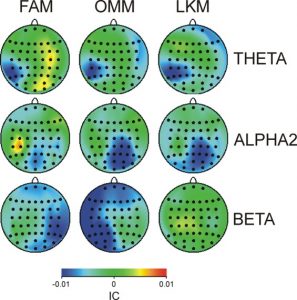Different Meditation Practices Have Specific Electrencepholographic Signatures
By John M. de Castro, Ph.D.
“the most general and consistently observed EEG correlate of meditation is an increase in the power of lower frequencies between 4 and 10 Hz corresponding to the theta band (4-8 Hz) and the lower end of the alpha band (8-10 Hz).” – Aaron Nitzkin
Meditation training has been shown to improve health and well-being. It has also been found to be effective for a large array of medical and psychiatric conditions, either stand-alone or in combination with more traditional therapies. One problem with understanding meditation effects is that there are, a wide variety of meditation techniques. Classically they’ve been characterized on a continuum with the degree and type of attentional focus. In focused attention meditation, the individual practices paying attention to a single meditation object. In open monitoring meditation, the individual opens up awareness to everything that’s being experienced including thoughts regardless of its origin. In Loving Kindness Meditation the individual systematically pictures different individuals from self, to close friends, to enemies and wishes them happiness, well-being, safety, peace, and ease of well-being.
One way to observe the effects of meditation techniques is to measure the effects of each technique on the brain’s activity. This can be done by recording the electroencephalogram (EEG). The brain produces rhythmic electrical activity that can be recorded from the scalp. It is usually separated into frequency bands. Delta activity consists of oscillations in the 0.5-3 cycles per second band. Theta activity in the EEG consists of oscillations in the 4-8 cycles per second band. Alpha activity consists of oscillations in the 8-12 cycles per second band. Beta activity consists of oscillations in the 13-30 cycles per second band while Gamma activity occurs in the 30-100 cycles per second band.
In today’s Research News article “Common and distinct lateralised patterns of neural coupling during focused attention, open monitoring and loving kindness meditation.” (See summary below or view the full text of the study at: https://www.ncbi.nlm.nih.gov/pmc/articles/PMC7198563/), Yordanova and colleagues recruited Buddhist monk, nuns, and novices who practiced focused, open monitoring, and loving kindness meditation. Their electroencephalogram (EEG) was taken during 3-minute periods of rest, focused, open monitoring, and loving kindness meditations.
They found that during all meditation conditions there was an increase in the synchronization of Delta activity throughout the brain, in Theta activity in the left hemisphere, and slow and fast Alpha activity in the right hemisphere. Hence, all three types of meditations produce common changes in the electrical activity of the brain. In addition, they also identified specific patterns of brain activity that differentiated the three meditation types. In particular, Beta activity synchronization was greatest in the right hemisphere during focused meditation and in the left hemisphere during open monitoring meditation, while during loving kindness meditation there were reduction in fast Alpha activity in the left hemisphere.
These are complex but interesting results that indicate that various meditation techniques have common changes in brain activity. That shouldn’t be surprising as these different meditation techniques produce very similar physical and mental changes in the practitioner. On the other hand, there were detected different patterns of activity for each meditation type. This again should not be surprising as there are differences in the effects of the meditation types. So, the electrical activity of the brain during these techniques correlates with their similarities and differences in their effects.
So, different meditation practices have similar and specific electrencepholographic signatures.
“Connectivity measures between EEG channels are also currently being studied to measure meditation. Some connectivity evidences are the synchronisation of anterior and posterior channels or alpha phase synchronicity.” – David Ibañez
CMCS – Center for Mindfulness and Contemplative Studies
This and other Contemplative Studies posts are also available on Google+ https://plus.google.com/106784388191201299496/posts and on Twitter @MindfulResearch
Study Summary
Juliana Yordanova, Vasil Kolev, Federica Mauro, Valentina Nicolardi, Luca Simione, Lucia Calabrese, Peter Malinowski, Antonino Raffone. Common and distinct lateralised patterns of neural coupling during focused attention, open monitoring and loving kindness meditation. Sci Rep. 2020; 10: 7430. Published online 2020 May 4. doi: 10.1038/s41598-020-64324-6
Abstract
Meditation has been integrated into different therapeutic interventions. To inform the evidence-based selection of specific meditation types it is crucial to understand the neural processes associated with different meditation practices. Here we explore commonalities and differences in electroencephalographic oscillatory spatial synchronisation patterns across three important meditation types. Highly experienced meditators engaged in focused attention, open monitoring, and loving kindness meditation. Improving on previous research, our approach avoids comparisons between groups that limited previous findings, while ensuring that the meditation states are reliably established. Employing a novel measure of neural coupling – the imaginary part of EEG coherence – the study revealed that all meditation conditions displayed a common connectivity pattern that is characterised by increased connectivity of (a) broadly distributed delta networks, (b) left-hemispheric theta networks with a local integrating posterior focus, and (c) right-hemispheric alpha networks, with a local integrating parieto-occipital focus. Furthermore, each meditation state also expressed specific synchronisation patterns differentially recruiting left- or right-lateralised beta networks. These observations provide evidence that in addition to global patterns, frequency-specific inter-hemispheric asymmetry is one major feature of meditation, and that mental processes specific to each meditation type are also supported by lateralised networks from fast-frequency bands.
https://www.ncbi.nlm.nih.gov/pmc/articles/PMC7198563/
